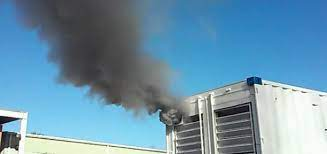On March 16, four Walden employees were certified in the United States Environmental Protection Agency (USEPA) Method 9 Air Opacity of Visible Emissions. New employees, Cari Covell and Ritu Chaugule, were obtaining the certification for the first time while Walden project managers, Erica Johnston and Massimiliano (Massi) Lelli, were there to be recertified.
A USEPA Method 9 Certified Emissions Evaluator conducts air opacity tests to assess air pollution from point source emissions. Most commonly, emissions from generators and smokestacks are monitored. In New York City, every generator at or above 40 kW output capacity registered or permitted with the New York City Department of Environmental Protection (NYCDEP) must be tested according to USEPA Method 9 procedures. NYCDEP modified these standards in the Rules of the City of New York under Title 15, Chapter 44, effective January 2017.
What is USEPA Method 9 for Air Opacity?
USEPA Method 9 is a method to determine and make observations of the opacity of an emissions plume using standardized procedures. The emission point is described and recorded relative to the observer’s distance and the sun. Plume direction, the height of the emissions source (stack), distance and direction to the emissions source, sun direction, and sun altitude are all aspects of observing an emissions plume. The opacity of the smoke is recorded to the nearest 5 percent on a scale of 0-100 percent.

Opacity is the obscuring power of an emission. Particulate matter creates opacity. The more background light blocked from an observer’s view by particulate matter emissions with a small diameter (< 400 nm), the higher the opacity reading. Opacity is considered upon reflection, refraction, absorption, and transmittance of light to the plume.
How are air emissions recorded?
Method 9 recommends monitoring emissions one hour after sunrise until one hour before sunset, not including mid-day, to minimize sun impedance. This is also while monitoring wind direction and speed, moving to different observation points if necessary. Individual readings are taken in momentary glances every 15 seconds for one straight hour. Federal limits on opacity require that, on a rolling average of six minutes, the opacity should not exceed 20 percent. However, NYCDEP regulations more strictly require that the 20 percent average of opacity should not be exceeded in any two consecutive minutes within a one-hour period. A trained observer knows how to read the stack for opacity within a 15 percent error margin.
Why Walden?
Walden can assist and make recommendations to our clients regarding generator operation. Opacity testing of generators triggers other compliance requirements with the NYCDEP, such as air permitting and aboveground tank registration. Our certified operators are available for testing and permitting inquiries at 516-559-6976.
